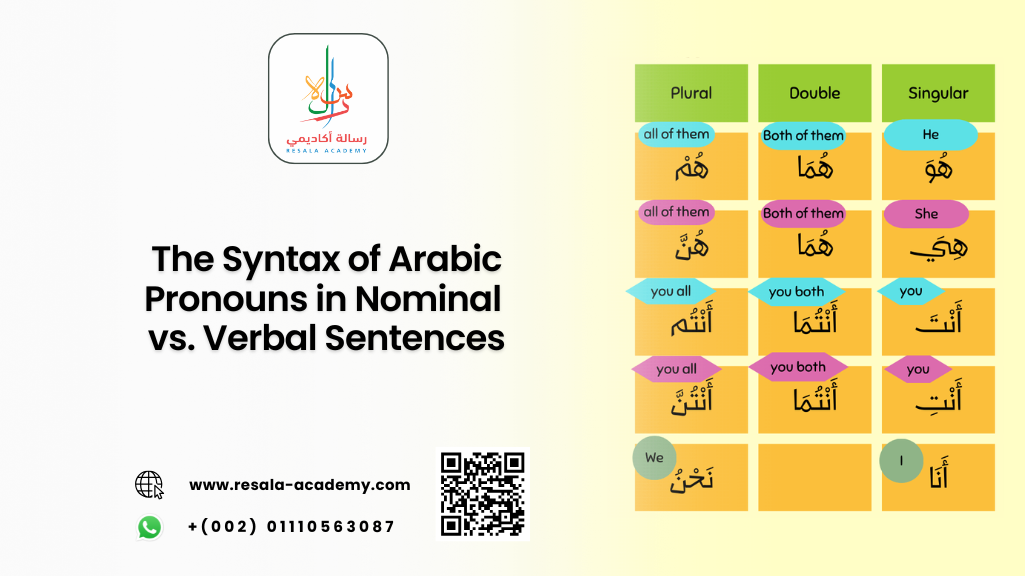Table of Contents
The Syntax of Arabic Pronouns in Nominal vs. Verbal Sentences
Learning Arabic as a non-native speaker can be both a rewarding and challenging journey. One of the most intricate yet foundational aspects of mastering the Arabic language is understanding the syntax of Arabic pronouns.
These tiny linguistic elements carry significant grammatical weight, especially when used in different types of sentences. In this comprehensive guide, we will explore the structure and function of Arabic pronouns in both nominal and verbal sentences, providing you with the tools to enhance your fluency and comprehension.
Whether you’re a beginner or an advanced learner, this article will help you navigate the complexities of Arabic grammar. And if you’re looking for expert guidance, Resala Academy stands out as a premier online platform offering Arabic and Quran classes tailored for non-native speakers.
Understanding Arabic Pronouns
Arabic pronouns (الضمائر) are essential components of the language, functioning as substitutes for nouns and playing a crucial role in sentence construction. They are categorized into:
- Independent Pronouns (ضمائر منفصلة): Stand alone and are typically used in nominal sentences.
- Attached Pronouns (ضمائر متصلة): Affixed to verbs, nouns, or prepositions, often used in verbal sentences.
Examples of Arabic Pronouns
| English | Arabic | Pronoun Type |
|---|---|---|
| I | أنا | Independent |
| You (m) | أنتَ | Independent |
| He | هو | Independent |
| She | هي | Independent |
| We | نحن | Independent |
| You (pl) | أنتم | Independent |
| They | هم | Independent |
Nominal Sentences and Pronoun Usage
A nominal sentence (الجملة الاسمية) in Arabic begins with a noun or pronoun and does not require a verb to be grammatically complete. These sentences are used to express states, identities, or descriptions.
Structure of Nominal Sentences
The basic structure is:
[Subject] + [Predicate]
When using pronouns, the subject is often an independent pronoun, and the predicate can be a noun, adjective, or prepositional phrase.
Example 1:
Arabic: أنا طالب
English: I am a student
Explanation: “أنا” (I) is the independent pronoun acting as the subject, and “طالب” (student) is the predicate.
Example 2:
Arabic: هي معلمة
English: She is a teacher
Explanation: “هي” (she) is the subject pronoun, and “معلمة” (teacher) is the predicate.
Key Points:
- No verb “to be” is used in the present tense.
- Pronouns are explicit and often at the beginning of the sentence.
- The predicate agrees in gender and number with the subject.
Read more about: Colors in Arabic for Beginners: A Step-by-Step Guide with Pronunciation and Usage
Verbal Sentences and Pronoun Integration
A verbal sentence (الجملة الفعلية) starts with a verb and is typically used to describe actions. In this structure, pronouns are often attached to the verb, either as a subject or object.
Structure of Verbal Sentences
[Verb] + [Subject/Pronoun] + [Object (optional)]
Example 1:
Arabic: كتبَ الدرسَ
English: He wrote the lesson
Explanation: “كتبَ” (he wrote) includes the subject pronoun “هو” (he) implied in the verb’s conjugation.
Example 2:
Arabic: قرأتُ الكتاب
English: I read the book
Explanation: “قرأتُ” includes the attached pronoun “تُ” indicating “I”.
Verb Conjugation and Pronouns
Arabic verbs change form based on the subject pronoun. Here’s a quick look:
- أنا كتبتُ – I wrote
- أنتَ كتبتَ – You (m) wrote
- هو كتبَ – He wrote
- هي كتبتْ – She wrote
- نحن كتبنا – We wrote
Read more about: How to Say and Write “Father in Arabic”: A Complete Beginner’s Guide
Comparative Syntax: Nominal vs. Verbal
Understanding the distinction between nominal and verbal sentence structures is crucial for mastering Arabic pronouns.
| Feature | Nominal Sentence | Verbal Sentence |
|---|---|---|
| Starts with | Noun/Pronoun | Verb |
| Pronoun Type | Independent | Attached |
| Verb Required? | No | Yes |
| Focus | Description/State | Action/Event |
Example Comparison:
Nominal: هو طالب
Verbal: يدرس في الجامعة
Translation:
- He is a student (Nominal)
- He studies at the university (Verbal)
Advanced Insights: Contextual Shifts in Arabic Pronoun Usage
Understanding the dynamic nature of Arabic pronouns requires more than memorization—it demands a grasp of how context influences their form and placement. In advanced Arabic syntax, pronouns adapt based on discourse flow, emphasis, and syntactic function.
- Emphatic Positioning: In formal Arabic, independent pronouns may be used redundantly for emphasis, even in verbal sentences.
- Example: أنا كتبتُ الرسالة (“I wrote the letter”) — “أنا” reinforces the subject “I”, despite being implied in “كتبتُ”.
- Topicalization: Arabic allows for fronting pronouns to highlight the topic of a sentence, especially in media or classical texts.
- Example: هم، لا يحبون التأخير (“They, they do not like being late”) — “هم” is fronted for topical emphasis.
- Contrastive Usage: When contrasting two subjects, Arabic pronouns are explicitly stated to clarify distinctions.
- Example: هو يدرس، أما هي فتعمل (“He studies, while she works”) — both pronouns are necessary for clarity.
- Ellipsis in Dialogue: In conversational Arabic, pronouns are often dropped when context is clear, especially in verbal exchanges.
- Example: كتبت؟ (“Did you write?”) — the pronoun is omitted but understood from context.
These nuanced applications of Arabic personal pronouns reflect the language’s syntactic flexibility and the importance of context in communication.
Specialized Structures: Pronouns in Relative and Conditional Clauses
Beyond basic sentence types, Arabic pronouns play a pivotal role in complex grammatical structures such as relative and conditional clauses. Mastery of these forms is essential for academic and literary Arabic proficiency.
- Relative Clauses (الجمل الموصولية): Pronouns often serve as antecedents or are embedded within the clause for cohesion.
- Example: الطالب الذي قرأ الكتاب هو مجتهد (“The student who read the book is diligent”) — “الذي” refers back to “الطالب”, replacing a repeated noun.
- Conditional Sentences (جمل الشرط): Pronouns shift based on the subject of the condition and result clauses.
- Example: إن درستَ، ستنجح (“If you study, you will succeed”) — “تَ” and “سَ” indicate second-person singular pronouns.
- Embedded Pronouns in Prepositional Phrases: In both clauses, object pronouns are often attached to prepositions.
- Example: الكتاب له (“The book is his”) — “له” combines the preposition “لـ” with the attached pronoun “ـه”.
- Pronoun Agreement in Dual and Plural Forms: Relative and conditional clauses must maintain number and gender agreement with the pronoun.
- Example: الطالبتان اللتان نجحتا (“The two female students who succeeded”) — “اللّتان” and “نجحتا” reflect dual feminine agreement.
These advanced syntactic environments illustrate the depth of Arabic pronoun usage and highlight why structured learning through platforms like Resala Academy is invaluable for serious students of Arabic.
Common Mistakes and How to Avoid Them
Non-native speakers often encounter challenges when using Arabic pronouns. Here are some common errors and how to correct them:
❌ Using independent pronouns in verbal sentences unnecessarily
✅ Let the verb conjugation imply the subject
❌ Mismatching gender or number
✅ Ensure agreement between pronoun and verb/noun
❌ Forgetting to attach object pronouns
✅ Example: أحبك (I love you) – “ك” is the object pronoun
Tips for Mastery
- Practice with both sentence types regularly
- Use flashcards for pronoun-verb combinations
- Enroll in structured courses like those at Resala Academy
Resala Academy: Your Gateway to Arabic Mastery
At Resala Academy, learning Arabic online is more than memorizing vocabulary—it’s about understanding the soul of the language. Their expert instructors specialize in teaching Arabic grammar, pronouns, and sentence structure to non-native speakers through:
- Live interactive classes
- Tailored curriculum for all levels
- Quranic Arabic for spiritual enrichment
- Flexible schedules and affordable pricing
Whether you’re aiming to speak fluently or understand the Quran, Resala Academy provides the tools and support you need to succeed.
Enroll today and transform your Arabic learning journey with Resala Academy.
FAQs
1. What is the difference between independent and attached Arabic pronouns?
Independent pronouns stand alone and are used in nominal sentences. Attached pronouns are affixed to verbs, nouns, or prepositions and are common in verbal sentences.
2. Do Arabic pronouns change with gender?
Yes. Arabic pronouns are gender-specific. For example:
- “هو” = he
- “هي” = she
Verbs and adjectives must also match the gender of the pronoun.
3. How do I know which pronoun to use in a sentence?
It depends on the sentence type:
- Use independent pronouns in nominal sentences.
- Use attached pronouns in verbal sentences, often embedded in the verb conjugation.
4. Can I omit pronouns in Arabic?
In verbal sentences, the subject pronoun is often implied in the verb conjugation. However, in nominal sentences, the pronoun is usually stated explicitly.
5. What’s the best way to practice Arabic pronouns?
- Use online exercises and flashcards
- Write your own sentences
- Join a structured course like Resala Academy for guided learning
Conclusion
Understanding the syntax of Arabic pronouns in both nominal and verbal sentences is a cornerstone of Arabic fluency. By distinguishing between independent and attached pronouns, recognizing sentence structures, and practicing regularly, you can significantly improve your command of the language.
For non-native speakers, the journey becomes easier and more enjoyable with expert guidance. Resala Academy offers a comprehensive and supportive environment to master Arabic grammar, pronunciation, and Quranic understanding.
So why wait? Take the next step in your Arabic learning journey with Resala Academy—where language meets purpose.




